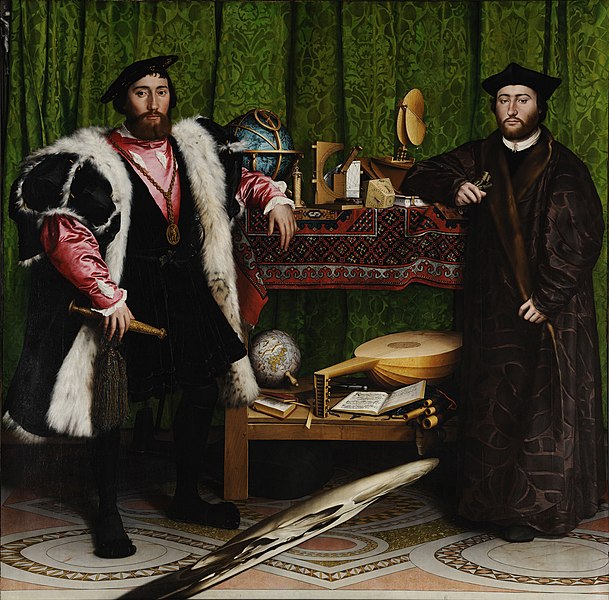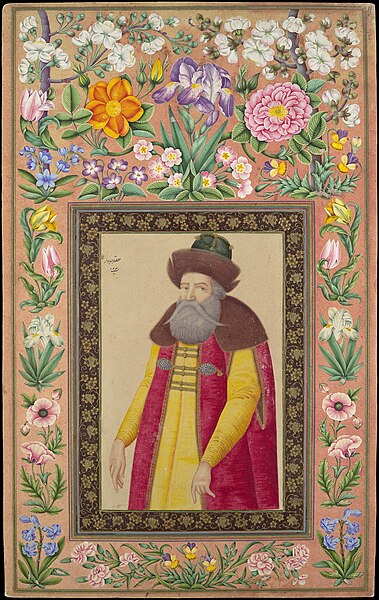 1
1title: Antoine de Favray Portrait of Charles Gravier Count of Vergennes and French Ambassador, in Turkish Attire - Google Art Project
artist: Antoine de Favray
date: Second half of the 18th Century
dimensions: w1130 x h1415 cm
current location: Pera Museum
credit: FwE9CRd6bdEHEw at Google Cultural Institute maximum zoom level
license:Public domain
 2
2title: Fausto Zonaro The Daughter of the English Ambassador Riding in a Palanquin - Google Art Project
artist: Fausto Zonaro
date: late 19th century
dimensions: w770 x h490 cm
current location: Pera Museum
credit: DgEjQZE4_U4kdg at Google Cultural Institute maximum zoom level
license:Public domain
 3
3title: Hans Holbein the Younger The Ambassadors - Google Art Project
artist: Hans Holbein
date: 1533
credit: bQEWbLB26MG1LA at Google Cultural Institute, zoom level maximum
description: Jean de Dinteville, French ambassador to the court of Henry VIII of England, and Georges de Selve, Bishop of Lavaur. The painting is famous for containing, in the foreground, at the bottom, a spectacular anamorphic, which, from an oblique point of view, is revealed to be a human skull. An Azerbaijanian vishapagorg rug is on the table.
license:Public domain
 4
4title: Canaletto Bucentaur's return to the pier by the Palazzo Ducale - Google Art Project
artist: Canaletto
source: link
credit: link
license:Public domain
 5
5title: Portrait of the Russian Ambassador, Prince Andrey Priklonskiy, Folio from the Davis Album
artist:
Ali Quli Jabbadar (active 1642–late 17th century)date: 1673
medium: Ink, opaque watercolor, and gold on paper
dimensions: 13.12 in. high 8.25 in. wide (33.3 cm high 21 cm wide)
current location: institution:Metropolitan Museum of Art
source: [link "Portrait of the Russian ambassador, Prince Andrey Priklonskiy", Folio from the Davis Album] ''www.metmuseum.org''
credit: "Portrait of the Russian ambassador, Prince Andrey Priklonskiy", Folio from the Davis Album www.metmuseum.org
license:Public domain
 6
6title: Shah Abbas the Great receiving the Mughal ambassador Khan’Alam in 1618
artist:
Unknown artistdate: 17th century
medium: Technique 1=Pigments on=paper
dimensions: Size unit=cm width=43.5 height=36.5
current location: Private collection of Alexis Renard :Similar copy in Institution:British Museum
source: [link alexisrenard.com] :[link British Museum version]
credit:
description: This painting is depicting Shah Abbas receiving the Mughal ambassador Khan ‘ Alam in 1618. Shah Abbas sits to the right of the composition in the middle of a hilly landscape offering a gold wine cup to the Mughal ambassador. Their suite composed by dignitaries, musicians and pages surrounds them.
A nasta’liq inscription identifying the scene has been rubbed at the bottom of the painting.
A closely related painting of a later date is kept in the collection of the British Museum and published in: Canby, S. (2009) Shah ‘Abbas – The Remaking of Iran, London: The British Museum Press, p. 63.
Our painting might be the prototype for the British Museum’s painting.
Another painting related in the treatment of the composition and the figures, recently acquired by the Custodia Foundation, is ascribed to the painter Farhad (Inv. 2009-T.23).license:Public domain
 7
7title: Pius V and the Ambassador of the King of Poland MET DR282
artist: Benedetto Luti
date: circa 1712
medium: Black and red chalk, brush and brown wash, highlighted with white
dimensions: 15-7/16 x 21-3/4 in. (39.2 x 55.2 cm)
current location: Institution:Metropolitan Museum of Art
source: link Template:TheMet
credit: This file was donated to Wikimedia Commons as part of a project by the Metropolitan Museum of Art. See the Image and Data Resources Open Access Policy
license:
CC0
 8
8title: Entry of the Polish Ambassador into Rome MET DP852906
artist: Stefano della Bella
date: 1633
medium: Etching; first or second state of three
dimensions: Sheet: 6 3/4 x 104 1/4 in. (17.1 x 264.8 cm)
current location: Institution:Metropolitan Museum of Art
source: link Template:TheMet
credit: This file was donated to Wikimedia Commons as part of a project by the Metropolitan Museum of Art. See the Image and Data Resources Open Access Policy
license:
CC0
 9
9title: Holbein ambassadorsFXD
artist: Hans Holbein
date: 1533
medium: technique oil and=tempera oak panel
dimensions: size unit=cm height=207 width=209
current location: Institution:National Gallery, London
source: Derived from|Holbein-ambassadors.jpg|display=120
credit: This file was derived from: Holbein-ambassadors.jpg:

description:
Holbein painted this work in the early part of his second stay in England, which began in 1532. At this time he was prolific, painting Hanseatic merchants, courtiers, landowners, and visitors. The Ambassadors is his most famous and perhaps greatest painting of this period. The life-sized panel portrays Jean de Dinteville, an ambassador of Francis I of France in 1533, and Georges de Selve, Bishop of Lavaur, who visited London the same year.
Until the publication of Mary F. S. Hervey's Holbein's Ambassadors: The Picture and the Men in 1900, the identity of the two figures in the picture had been a matter of intense debate. In 1890, Sidney Colvin was the first to propose the figure on the left as Jean de Dinteville, Seigneur of Polisy (1504–1555), French ambassador to the court of Henry VIII for most of 1533. Shortly afterwards, the cleaning of the picture revealed his seat of Polisy as one of only four places marked on the globe. Hervey identified the man on the right as Georges de Selve (1508/09–1541), Bishop of Lavaur, after tracing the painting's history back to a 17th-century manuscript. Hervey's identification of the sitters has remained the standard one, affirmed in several extended studies of the painting. However, rival speculation is not entirely dead. Opposition to the identification of de Selve has been based on an inventory of 1589, discovered by Riccardo Famiglietti, which names the man on the right as de Dinteville's brother François. Leading scholars of the painting argue that this identification of 1589 was incorrect.license:Public domain

title: Ambassador Anderson's Party for Ambassador Hughes at the Crillon, Paris in June 1953 DPLA - 3557fd74733826049016a0dadf825582
artist: unknown
date: 1948-01-01/1967-12-31
credit: This file was contributed to Wikimedia Commons by National Archives at College Park - Still Pictures as part of a cooperation project. The donation was facilitated by the Digital Public Library of America, via its partner National Archives and Records Administration. National Archives Identifier: 20004194 Source record: link DPLA identifier: 3557fd74733826049016a0dadf825582
license:Public domain





